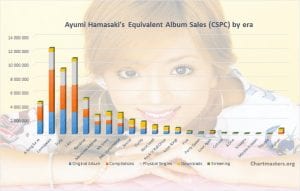Forum
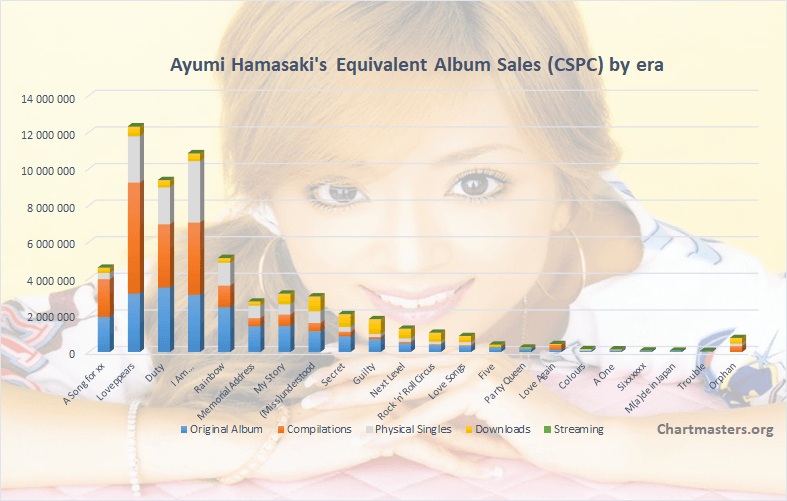
Unless you are an avid chart follower or well aware of the Japanese culture, the name of Ayumi Hamasaki surely doesn't speak to you.
In her homeland though, the diva used to be unstoppable, hitting the #1 position with 25 singles in a row at some point. Get to know the one who was regarded as Japan's Madonna at the turn of the century!
Get to know Ayumi Hamasaki
Ayumi Hamasaki is a Japanese star singer, born in October 2, 1978. She has been the songwriter of most of her hits. Raised by her mother and grandmother after the departure of her father when she was only 3, she started modelling, then acting and singing from a young age.
After a first failure in 1995, Ayumi Hamasaki issued various singles from mid-1998 to growing success until exploding in 1999 with her proper debut album A Song For XX.
After 3 super successful albums in Japan, her 4th, titled I Am..., marked her peak abroad with strong success in multiple Asian markets.
Ayumi Hamasaki has been highly prolific ever seen she debuted. She is up to 17 studio albums plus 4 mini albums. We then need to add 37 live, remix and compilation records, 42 VHS/DVDs, 105 physical singles and even more music videos filmed.
First of all, if you happen to be from Japan or fan of their culture, I must apologize for writting Ayumi Hamasaki instead of Hamasaki Ayumi. In fact, the norm there is to write down the lastname first. We went by the international standard to avoid confusion.
Ayumi Hamasaki is part of an elite group of massive sellers in Japan along with B'z, Mr. Children, Hikaru Utada and Namie Amuro. All of them dropped multi-million sellers at their peak and made it look easy.
The former herself illustrates this fact very well since her 2001 compilation A Best sold 2,874,870 during its first week in Japan. Globally, this remained the second highest debut ever until Adele's 25.
The irony is that it debuted at #2 after a legendary battle against Hikaru Utada's Distance which opened with 3,002,720.
This piece of history is illustrated below, please notice that Japanese numerals just like Chinese numerals use to group large numbers by 10,000. On its book, Oricon displays them with a factor of 10.
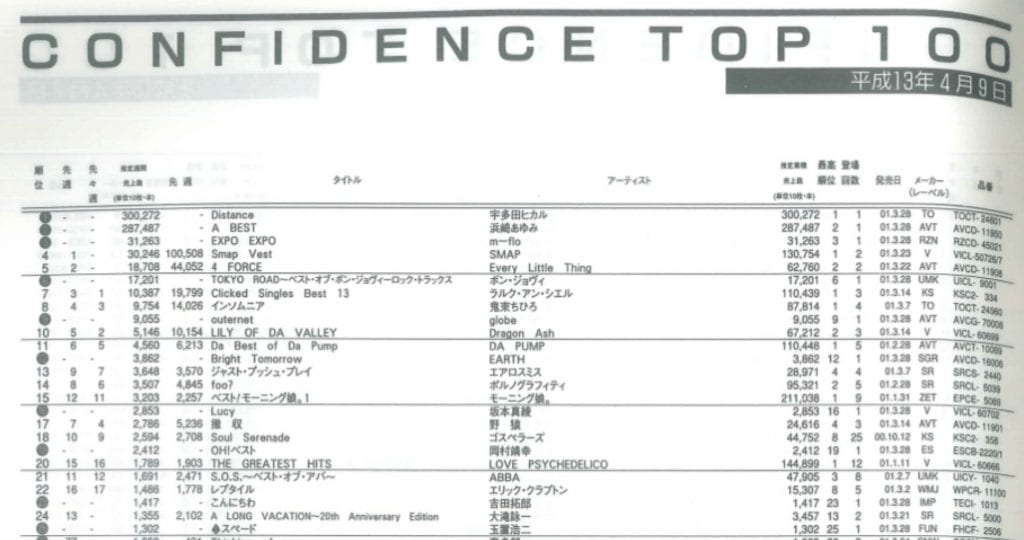
So, with an extensive discography and an insane ability to sell well, how many units has Ayumi Hamasaki moved in total?
Also, J-Pop is often claimed to have been highly hyped abroad in late 90s / early 00s, in a way similar to K-Pop in recent years. Has she sold that well abroad, and how much?
As usual, I'll be using the Commensurate Sales to Popularity Concept in order to relevantly gauge her results. This concept will not only bring you sales information for all Ayumi Hamasaki's albums, physical and download singles, as well as audio and video streaming. In fact, it will also determine their true popularity.
If you are not yet familiar with the CSPC method, below is a nice and short video of explanations. I fully recommend watching it before getting into the sales figures. Of course, if you are a regular visitor feel free to skip the video and get into the numbers directly.
The Commensurate Sales to Popularity Concept (CSPC)
There are two ways to understand this revolutionary concept. The first is the Scribe video posted below. If you are unaware of the CSPC method, you will get the full idea within just a few minutes.
If you are a mathematical person, and want to know the full method as well as formulas, you can read the full introduction article.
Now let's get into the artist's sales figures in detail in order to apply this concept and define the act's true popularity!
Ayumi Hamasaki Album Sales

Original Album Sales - Comments
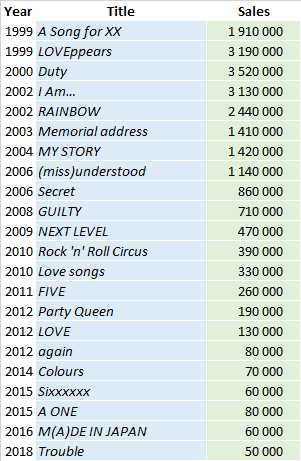
Ayumi Hamasaki debuted very strong with an album that sold near 2 million copies.
Rather than dropping fast, she issued LOVEppears which confirmed all her potential. The album is past 3 million global sales.
So are the next two, Duty and I Am... . During this period, the diva was at the top of the game.
Rainbow was slightly weaker but still an amazing seller.
The negative trend was engaged though. With the collapse of various Asian markets, including Japan, sales were less and less with almost every album.
The next 3 still sold over a million a piece. Then Secret and GUILTY sold 1.57 million combined.
From 2009 numbers dropped by half a million per release, then below 100,000 units from 2012.
Since the peak of Duty it's obvious that her sales went downhill but it doesn't change the fact that her album sales add for a tremendous 21.9 million.
As for these numbers, I need to explain them a bit because of the specific nature of the information.
There is a lot of inflated data online, most notably for sales overseas, including a lot credited to myself.
The main reason is that Avex, the singer's label, shared a lot of her figures through financial reports. Fans assumed all figures were exclusively for sales in Japan.
Once we dig into her discography, we notice that most of her records were issued only in Japan, Hong Kong and then Taiwan or China.
The latter two versions were sold through all these countries, Hong Kong, Taiwan and China. You can notice most of her albums weren't released in Southeast Asia though.
Many of them did chart on J-Pop rankings of countries like Malaysia or Singapore. The fact is that units sold there were Japanese exports.
The gap between Oricon figures (the Japanese equivalent to Soundscan) and Avex, often assumed to be sales off panel, were actually a large share of the albums' sales overseas added to overshipments.
Indeed, we will see in following section that several of her physical singles were limited to 300,000, and they did reach almost that figure according to Oricon, which reflects how comprehensive the system has been for long.
A fact often overlooked too is that these exports do not only appear into financial reports, they are also eligible for RIAJ certifications.
That's why artists like Arashi or BTS (with their Japanese releases) have certifications way higher than their Oricon sales, because they are strongly popular elsewhere.
Also, please notice that for convenience purpose exports have been added to Asian totals, since it's where most of them went. Ayumi Hamasaki still sold a few copies of her records in markets like the US or Europe.
Another thing which conclude on overestimations is that when we see an artist so popular in Japan, Taiwan, Hong Kong, we believe she is popular all over Asia.
J-Pop did cross over the masses in Taiwan and Hong Kong, but not elsewhere. In markets like Malaysia and South Korea, the phenomenom was limited.
In these markets, Ayumi Hamasaki did chart well on J-Pop rankings, it's just that the J-Pop genre as a whole wasn't so strong, representing a tiny share of markets which were themselves dying faster than we used to assume.
All in all, Japan still accounted for a massive share of her sales, more than 80% to be precise.
Ayumi Hamasaki Song Sales

Physical Singles

As a reminder, the weighting is done with a 10 to 3 ratio between albums and standard physical singles, 10 to 5 between albums and maxi singles.
The first element to point out with Ayumi Hamasaki's singles list is that her catalog has been exploited through countless reissues on several formats, that's why her list is so incredibly long.
Her first era, A Song for XX, had 5 traditional singles. The first two Poker Face and You peaked at #20. The following 3 all peaked in the second half of the top 10.
LOVEppears' lead single Whatever went to #5 with sales of 225,000 units, similar to previous singles.
The era went through the roof with Love (Destiny), the pop star first chart topper. To Be wasn't so strong, but then both Boys & Girls and A topped charts with over a million sales each.
It's important to highlight that most of these singles were EPs more than anything. A for example was a four-A side single. Sales of 1.7 million units are thus highly valuable.
Kanariya was the fourth #1 of the era, which also had 4 more top 5 hits, almost nothing.
From Duty, both Vogue and Far Away failed the top spot because of strong competition, but they stil sold very well.
Seasons was the top hit of the record. It went to #1 and moved over 1.4 million units, while Surreal was also #1.
Things got even more insane with the era I Am... which got 8 proper singles. The first 7 were all #1s with 6.5 million combined sales.
The last single Daybreak went to #2, the only single from the singer to miss the top from late 2000 to 2011.
You got it, every single of albums from Rainbow to Love Songs have been #1s.
With both the market going down and the diva popularity going steadily down they sold less and less, but still enough to bring her cumulative total to a gigantic 26 million units.
The last 3 orphan songs have been arguably given away at concert avenues in recent years. Since their price was actually accounted for into concert tickets, they are basically bundles. Since they are eligible for sales in the US, they have been listed here too.

Digital Songs

As a reminder, the weighting is done with a 10 to 1,5 ratio between albums and digital singles.
For very long, we considered Japan as a country late into the digital arena. The truth is pretty much the opposite.
While Oricon did take its time until accounting for them, ringtones took over in Japan before anywhere else.
During 2004, when iTunes was getting started, 220 million ringtones were sold in Japan.
It's traditional downloads which came a bit later, ultimately peaking in 2014 at 109 million sales. Once we add ringtones and downloads, over 3.5 billion have been sold in Japan. These are much healthier numbers than often assumed for this market.
Ayumi Hamasaki, in spite of selling tons of physicals, fully enjoyed this great digital market.
She has over 25 songs from her debut to 2003's Memorial Address with relevant numbers. These sales were mostly achieved through the years, by the tracks which remain classics.
The biggests of them all happen to be Seasons and M, songs around 1 million digital sales to date.
By 2004 it was already possible to register huge ringtones sales upon release. The best example of this is Carols which quickly went all the way up to over 1 million sales in this format.
The remaining singles from My Story, Inspire and Moments, once accounting for everything, are also close / on 1 million sales.
Following albums were all home to strong digital hits. (Miss)understood contained 3 million sellers, with Heaven closing counts at a massive 1.9 million.
From Secret, Blue Bird did over 1.5 million while Jewel was too far behind.
With Guilty, she got 10 singles that landed into the Monthly Ringtones Chart. This madness led its songs to crack 5 million total sales, with both Together When... and Glitter million sellers. The former was #1 in this format.
The #2 digital song Days kept alive the string of consecutive eras involving million sellers. Tracks from Next Level combine for over 3.5 million sales.
While the market started to go down on the back of decreasing ringtones, 2010's era Rock 'n' Roll Circus was still magnificent for the singer in terms of digital sales.
As many as 11 songs landed into the newly launched Digital Track Chart, with Sunrise (Love Is All) hitting two weeks at the top while breaking over a million combined sales. #3 hit You Were… came close too.
Her songs started to have less and less longevity from that point, ultimately selling less in spite of great peaks. The era Love Songs was consistent still with 2.2 million total sales.
Later promotional campaigns were arguably weaker, both because of the market drop and the lack of impact from the new songs.
All inclusive, Ayumi Hamasaki has sold a stunning 46.5 million digital singles, most of which in Japan.

Streaming
Streaming is made up of audio and video streams. Our CSPC methodology includes both to better reflect the real popularity of each track. The main source of data for each avenue is respectively Spotify and YouTube. To factor in the growing impact of multiple Asian countries where these platforms aren't always the go-to site for music streaming, more sources have been added.
In order to account for their real popularity in each relevant country, the below sources have been used along with the mentioned ratios that reflect the market share of each area.
Audio Streams
– South Korea : Genie streams * 3.05 (consistent with Gaon streaming numbers)
– Japan : AWA streams * 100/5.5 /4 (AWA has 5.5% of the Japanese streaming market but Ayumi Hamasaki outperforms the market by 4 to 1 in this platform because she was exclusively there at some point)
– Elsewhere : Spotify streams * (370 – 8.5 – 9.5 – 33 - 9) / 207 (370 million global subscribers minus 8.5 million from South Korea minus 9.5 million from Japan minus 33 million from China divided by the number of Spotify only users minus 9 million more Asian users) + Genie streams * 3.05 (uses Genie rather than Spotify to extrapolate markets like Taiwan, Thailand and Vietnam)
Video Streams
– China* : Xiami streams * 125/6.5 (Xiami has just over 5% of the Chinese streaming market)
– Elsewhere : Youtube views
*since 96.4% of Chinese streaming platforms are free users, that paid-for users pay less than $2 a month and that they are also used as video streaming platforms, their streams are weighted in par with YouTube streams.
Audio Stream - 1500 plays equal 1 album unit
Video Stream - 11,750 views equal 1 album unit
Equivalent Albums Sales (EAS) = ( Spotify * 310/207 + Genie * 3.05*2 + AWA * 100/5.5 *0.25) / 1500 + ( Xiami * 125/6.5 + YouTube ) / 11750
Top Hits
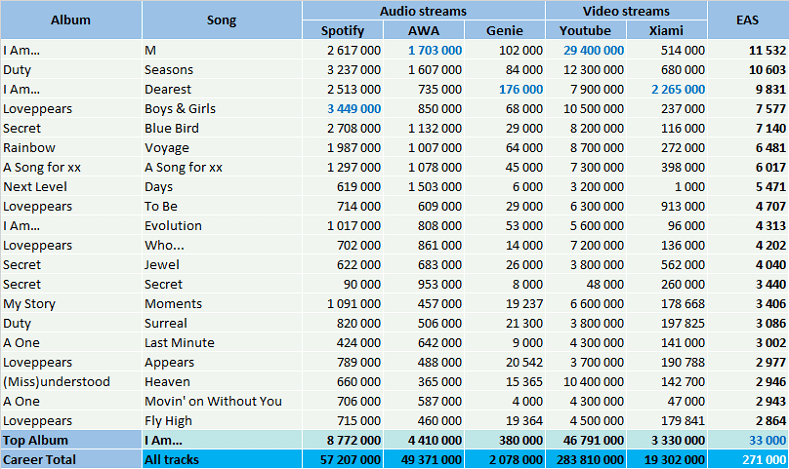
Unlike digital sales, streaming really is late in Japan, hence the fairly modest EAS numbers of Ayumi Hamasaki. She also adopted multiple techniques through the years, like remaining exclusively available on AWA, a platform with only 5.5% of the market share.
With this context it's harder to reach conclusion. An obvious one still is that her back catalog hits are much, much stronger than her recent outputs.
Her entire top 10 is made of songs which are from 10 to 20 years old each.
M leads in both Japan and YouTube, while Dearest tops South Korean and Chinese platforms. Both songs are from I Am..., her 2001 classic.
Naturally, it is also her top album with 33,000 EAS.
Full catalog breakdown
If you are familiar with the artist's catalog and want to check details of each and every song, you can access to all of them right here.
Keep yourself up to date
Our website provides you a fantastic tool which fetchs updated Spotify streams as you request them, use it to watch these results grow day after day!
Ayumi Hamasaki compilations sales
It sounds fairly logical to add together weighted sales of one era - studio album, physical singles, downloads, streams - to get the full picture of an album's popularity. For older releases though, they also generate sales of various live, music videos and compilation albums.
All those packaging-only records do not create value, they exploit the value originating from the parent studio album of each of its tracks instead. Inevitably, when such compilations are issued, this downgrades catalog sales of the original LP.
Thus, to perfectly gauge the worth of these releases, we need to re-assign sales proportionally to its contribution of all the compilations which feature its songs. The following table explains this method.
The distribution process

How to understand this table? If you check this example of the A Best, these figures mean it sold 5,330,000 units worldwide. The second statistics column means all versions of all the songs included on this package add for 67,514 equivalent album sales from streams of all types.
The second part on the right of the table shows how many equivalent streams are coming from each original album, plus the share it represents on the overall package.
Thus, streaming figures tell us songs from LOVEppears are responsible for 39% of A Best tracklist attractiveness, which means it generated 2,103,000 of its 5,330,000 album sales and so on for the other records.
Compilations sales figures listing

If you though you had seen it all about the iconic Japanese singer, here is the list of her 10 million selling compilations, 5.8 million selling remix albums and 2.8 million selling music videos. Not bad, right?
Full Length related records Sales – Summary
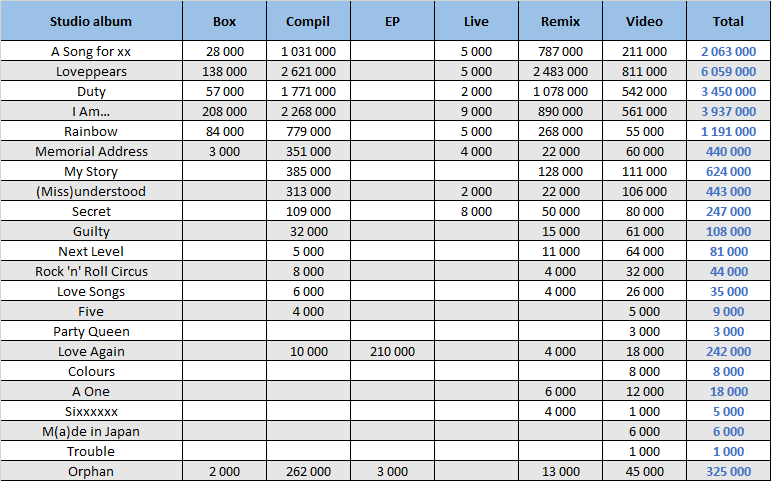
Here is the most underestimated indicator of an album’s success – the amount of compilation sales of all kinds it generated. Due to the dependency of sales of the original studio albums on these releases, they are a key piece of the jigsaw.
These numbers are obtained by applying the method from the section The distribution process to all packages listed under Compilation sales figures listing category.
What doesn't immediately strike when we see the list of studio albums of Ayumi Hamasaki is that her label dropped a wild number of records repacking her hits in years 2000-2003.
We can see with this table that LOVEppears alone powered sales of 6 million compilations. Her first 4 albums are in a league of their own with 15.5 million combined sales out of 19.3 million.
Ayumi Hamasaki Career CSPC Results

So, after checking all the figures, how many overall equivalent album sales has each Ayumi Hamasaki album achieved? Well, at this point we hardly need to add up all of the figures defined in this article!
Albums CSPC results
In the following results table, all categories display figures in equivalent album sales. If different, pure sales are listed between parentheses.
As a reminder:
- Studio Album: sales of the original album
- Other Releases: sales of compilations generated thanks to the album
- Physical Singles: sales of physical singles from the album (ratio 3/10)
- Download Singles: sales of digital singles from the album (ratio 1,5/10)
- Streaming: equivalent album sales of all the album tracks (ratio 1/1500 for Audio stream and 1/6750 for Video stream)
Artist career totals
See where the artist ranks among remaining singers
Numbers of the diva are absolutely incredible. Her trio of records LOVEppears, Duty and I Am..., released over a span of 26 months only, adds for an utterly insane 32.6 million equivalent album sales.
With sales ranging from 9.4 million to 12.3 million, they all belong to the most successful albums of all-time in Japan.
Both Rainbow and A Song for XX are incredible sellers as well with nearly 10 million combined.
Memorial Address, My Story and (Miss)understood sold about 3 million units each. They are seen are much weaker than her early albums, and they are, but cross-formats figures for them are still outstanding.
We go down a million to meet both Secret and Guilty, then one more to see Next Level and Rock 'n' Roll Circus. That's 12 million sellers for the superstar.
Sales went down through the years but in all fairness these were still healthy numbers up to Love Again.
Later releases are really pale in comparison with her fanbase kind of disappearing in the process, let alone her cross over appeal.
The overall total of Ayumi Hamasaki stands on 60.94 million equivalent album sales. How incredible is that?
Singles CSPC results
The list is compiled in album equivalent sales generated by each song. Therefore, these figures are not merged units of singles formats. Instead, it includes weighted sales of the song's physical single, download, ringtone and streaming as well as its share among sales of all albums on which it is featured.
1. 2000 - Ayumi Hamasaki - Seasons [Duty] - 5,470,000
2. 2000 - Ayumi Hamasaki - M [I Am…] - 3,840,000
3. 1999 - Ayumi Hamasaki - Boys & Girls [Loveppears] - 3,250,000
4. 2002 - Ayumi Hamasaki - Dearest [I Am…] - 2,220,000
5. 1999 - Ayumi Hamasaki - To Be [Loveppears] - 1,950,000
6. 1999 - Ayumi Hamasaki - A Song for xx [A Song for xx] - 1,940,000
7. 2002 - Ayumi Hamasaki - Voyage [Rainbow] - 1,890,000
8. 2001 - Ayumi Hamasaki - Evolution [I Am…] - 1,620,000
9. 2000 - Ayumi Hamasaki - Surreal [Duty] - 1,530,000
10. 1999 - Ayumi Hamasaki - Appears [Loveppears] - 1,460,000
If you feel inspired by this list, we just created this CSPC Ayumi Hamasaki playlist on Spotify!
Discography results
Thanks to our new ASR (Artist Success Rating) concept, we know that her sales represent 11,44 million times the purchase of their discography. Coupled with her total sales, it translates into an ASR score of 150. The ranking of all artists studied so far is available too at this link.
Records & Achievements
- At 38, Ayumi Hamasaki has the most #1 single in Japan history for a female solo artist.
- At 25, Ayumi Hamasaki has the most consecutive #1 single in Japan history for a female artist.
- At 12 (1999-2010), Ayumi Hamasaki has the most consecutive years with at least one #1 single in Japan history for a female solo artist.
- At 13 (1999-2011), Ayumi Hamasaki has the most consecutive years with at least one #1 album in Japan history for a female solo artist.
- At 12,335,000 EAS, LOVEppears is among the top 10 most successful non-English speaking album of all-time.
- At 2,874,870 pure sales, A Best recorded the 3rd biggest debut of all-time globally.
NB: EAS means Equivalent Album Sales.
You may be interested in...
... best-selling artists, albums, and singles
To improve your navigation we created several amazing cross-artists lists posted inside the CSPC: Data Collector article. Click on it to see the full listing of all CSPC results compiled so far!
... similar artists
To put figures from this article into perspective, click on the images below to reach career breakdowns of similar artists:

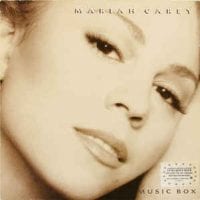
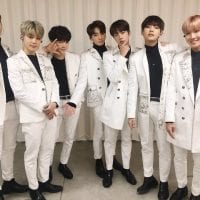
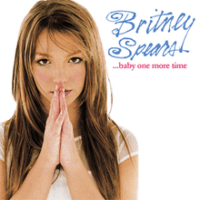
As usual, feel free to comment and / or ask a question!
Her total is higher than I expected! Even as someone somewhat familiar with Hamasaki's career arc I didn't realize how massively her albums were exploited - like Loveppears earning 75% of its EAS from compilations and singles, that's shocking for a 1999 release. I imagine this must have been quite a big task even without having to account for as many markets as usual.
Thank you for the analysis, I'm glad to see local artists being studied!
It's kinda sad seeing someone drops to 50k per album from multi-million figures.
Do Luis Miguel please. Im loving this analysis on top sellers from different countries. And I must admit, 60 million is an insane number for someone who have very limited market reach. That is bigger than someone like Christina Aguilera, who is a global superstar herself.
You should make more analysis about local artists in other countries like Dalida,Nana Mouskouri,Tatu,Tarkan,Eros Ramazatti,Julio Iglesias etc
Great work as usual
Im Vietnamese and Jpop is fairly a niche market here. Nowhere as popular as Kpop.
But I always assume Utada Hikaru is bigger than Ayumi Hamasaki. From what I understand: Utada - Ayumi - Namie. Is that correct
In CSPC terms, I really doubt Utada Hikaru would top Hamasaki Ayumi. I could see her ASR being higher, but I'm not sure Utada's most successful albums actually measure up to Hamasaki's, other than First Love which should be ahead of any of them.
That said, Utada and Amuro have both maintained their popularity in recent years much better than Hamasaki. Her name is never mentioned here but I wonder where Matsutouya Yumi would rank. If I recall correctly her Oricon total to date is actually higher than Utada or Amuro.
There's no way Utada is bigger than Hamasaki really, in overall CSPC Hamasaki might be over Utada and Amuro combined actually, but in terms of popularity at the moment they're both very likely above her.
For international success there's not even doubt that any of Hamasaki's albums even came close to First Love when it comes to sales outside of Japan. But in foreign success for their entire catalog the answer is more unclear really, although Utada is definitely the more popular one outside of Asia in the US and such.
First Love is likely above any of Hamasaki's albums but the follow ups really didn't hit as well, although still massive albums for Japanese standards. Hamasaki's real edge over her really is that her catalog is just so much bigger.
For Matsutoya I wouldn't be surprised really if she outsold both Utada and Amuro in CSPC, she got a higher Oricon total and she's been around for much longer which means a lot more of her sales have probably gone untracked by Oricon but on the other hand her digital and international success is deifinitely pale in comparison to the two.
Hi,
Arigato MJD for this, it's very interesting to study the numbers of a Japanise artist, as they are very huge seller for a lot of them ! And indeed, her numbers are impressive, stronger than many overall artists
Was it hard to find the datas of her carrier ? Because Japanese seem to publish the exact number of sales each weeks.
Looking back over the article, I just noticed a few typos - in the Downloads section chart, for My Story, all 3 of its singles have the same total (210,000) which is lower than stated in the article itself.
This is less important, but I am... was released in 2002, so the time span from Loveppears to then would be 26 months, not 14.
Also, the link to the ASR ranking in the Discography results section is broken.
Two takeaways:
1. Can you include a breakdown of sales for "A Best"
2. Does this mean we'll be getting more international/non-English speaking artists? If so I would love to see Utada Hikaru (who I've always read is supposed to be Ayumi's rival) and Mylene Farmer, considering you've posted her French sales before.
I'm highly suspicious on your first statement that Hamasaki might be over Utada and Amuro combined, I'm pretty sure that's not gonna happen though. Utada has roughly 40 million Oricon sales (English albums included) while Amuro has 35 million or higher. So the pure sale combined already over 60.94 million CSPC album results by Hamasuki, and the number will be even bigger after CSPC manipulated, correct?
Utada's and Amuro's Oricon sales are all just PHYSICAL sales, they sold less in digital. Ayumi is the 3rd best-selling artist in digital singles of all-time in Japan, while Utada is the 8th, and Amuro didn't even appear in the top 10. Also, singles reprensent a huge share of their Oricon physical sales, while 3.3 singles only equal to 1 album.
There is no competition with Christina really. They are not at the same level. According to Oricon, Ayumi Hamasaki has sold over 120 billion yen in physical record sales alone. That equals to 1.2 billion US dollars. That's even without digital singles, which Ayumi sold 46.5 million units(while in Japan only 4 digital singles can equal to 1 album on price). Ayumi Hamasaki is the best-selling female artist globally of the last 25 years in US dollars.
Well yeah but u need to consider the fact that she sold a lot more records than anybody else throughout the last 25 years. And she is definitely not the best selling female artist over the last 25 years. If she really sold 1.2 Billion records then her CSPC should have already been between 80-100 million already. That is unless u dont believe xhartmasters are accurate. Furthermore I really2 doubted she can beat Britney Spears sales. Are u telling me that she beat Britney Spears 65 million albums vs 22 million albums and 83 million downloads vs ur claim 46.5 million. And she barely leads Britney im the physicle singles and DVD/Compilation department. For sure Britney has created far more value than her. And Im pretty sure Rihanna, Taylor Swift, etc has created more value than her too. So shes definitely not the biggest selling female artist globally for the past 25 years.
Hi Orange!
I fixed the last two, I'll fix the first one once I have the file at hand 🙂 the total in the final table is correct if you want the real EAS value!
Hi Isaiah!
Yes sure for the breakdown. About international artists, it's more an opportunity thing. We love to portray different artists, we always learn a lot from them. Here for example I strongly improved the methods to estimate Japanese downloads. Luis Miguel or Julio Iglesias would be nice additions, we already did French / Japanese acts, a Latin one would be great.
Hi Bill!
Physical singles are worth 0.3 units under CSPC (0.5 for singles with 4+ tracks) so CSPC numbers can easily be lower than Oricon figures, it depends on the share of singles / how much the artist sold off radar or abroad and digital sales.
Did you understand me? No. Ayumi only sold 61 million EAS, while Britney sold nearly 110 million. In sales copies, Ayumi sold less than what you mentioned. But, in Japan, records were sold three times more expensive in US and Europe, and even much more expensive than places like poor Latin America and Southeast Asia. Ayumi sold 120 billion yen=1.2 billion US dollars with 50 million physical copies scanned byOricon, which shows her records were sold at $25. And singles are even sold cheaper, meaning that albums sold way much higher on price! maybe at over $30~$40! Also, In Japan, 4 digital singles equal to 1 physical album,meaning that their digital single sales were selling at at least $7.5, while in US ringtones were sold at only $2.5 and downloada at only $1. In US and Europe, albums were sold only at from $10 to $13. Compared to Japan, Ayumi's album and singles together were sold at $25, meaning that maybe her albums were sold at at least $30~$40! Now you understand? What I mean is in money! record value! money! not sales copies. Ayumi made much more on sales value/money, because Japanese records were sold much more expensive than any other parts of the world. Any other parts of the world. Also, Ayumi sold 120 billion yen in physical sales, this is officially scanned by ORICON, which is lack of sales off panel. She would sold even more adding catalog sales and digital sales. She is difinetely the best-selling female artist globally of last 25 years in record value/money. Also,it is chartmasters's founder MJD who confimed 37.8 million albums, 26 million physical singles and 46.5 million digital singles for Ayumi. Not me,not me confirming.
I understand exactly what u mean. Even after factoring in Japan's higher prices Britney would still be leading. She has sold 103 million equivalent album sales. Times by 12-14 Dollars, that would already be 1.3-1.4 billion dollars. Chartmasters confirmed Ayumi sold 26 million studio albums for Ayumi and 37.8 plus compilation, DVD's etc vs Britney 65 Million studio albums + 12 Million for compilation, DVD'S, etc. When I refer to 65 million vs 26 million albums I mean studio albums. That us why later on I also mentioned their compilation/DVD stats. Furthermore u are assuming that Britney sold zero albums in Japan and other South East Asian markets when she sold a lot there despite what u said are much more expensive than in Europe/US. She sold around 4 million albums in Japan which we have to multiply by 30 dollars instead of 10-14. Plus she probably sold a lot of Down loads in Japan too. Not to mentioned back in the late 90s, early 00s CD's are a bit pricier than it is today. I read somewhere that in Germany it reached 17-19 Euro and in the UK it was something like 12 pound. Now that is already 18-25 US dollars. Her total should definitely be a little bit more than 1.4 Billion dollars. Last but not least Britney has way more streams than her which is absolutely non existent. Britney managed to get 4 million eas from streaming alone wherelse she had less than 500k. That alone is already a big difference. And its only getting wider.
No, you still don't get it. Oricon scanned 120 billion yen=1.2 billion dollars with 50 million physical albums and singles for Ayumi. That means that her records were selling at $25. Considering that Ayumi scanned 29 million albums and 21 million singles by Oricon, and singles were sold cheaper than albums, her albums were at least sold at over $35. Oricon didn't count catalog sales, exports and digital sales, which all reprenst a large share of record value. Ayumi sold 61 million EAS,so that would be around 2.1 billion dollars. Then, a lot of Britney albums sold in Japan were imports, which were sold at the same price as US albums, also, international releases were always sold cheaper than domestic idol releases. That's why actually the whole Japan actually don't havean averange album price at over $35, but Ayumi did it. Domestic idol releases were always more expensive. Plus, for Britney, 3.25 million in Japan is nothing compared to 77 million worldwide. Considering she sold over 10 million albums in Southeast Asia and Latin America, where album price were very low, this did downgrade her averange album price. Assuming her albums were sold at $16 with 103 million EAS,that is 1.6 billion. No doubt that she sold less than Ayumi in sales value, it is reported that at Ayumi's peak, she is only less lucrative than Madonna.(repeating, this is "at her peak", not carrer total). I can still maybe find a lot of article like that for you. Southeast Asian albums were so cheap,albums were sold at $3 to $8 in places like Thailand or Philippines, don't know why you mention that. Ayumi's Southeast Asian fans were buying Japanese exports, which were sold at over $35. They don't want cheap local ones since they are no collecting value. I read an article that in 2000, 16% CD exports from Japan were Ayumi Hamasaki's(exports were not counted into Oricon, but counted into RIAJ and label shipments). You can see her power in Asia outside of Japan. STREAMING were already counted into EAS, there is no need to mention streaming at all.
